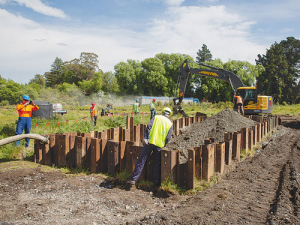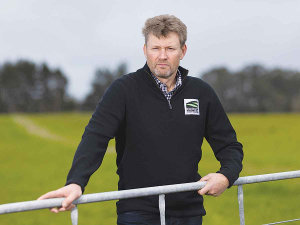Nitrate levels in groundwater have been reduced from 7.1mg/L to 0.5mg/L at the site of a denitrification wall trial in Canterbury.
The Institute of Environmental and Scientific Research (ESR) led the trial at Silverstream Reserve.
The 25m-long wall, installed eight weeks ago, is a world-first as denitrification walls haven’t been tested in fast-flowing gravel aquifer systems like those found in Silverstream.
ESR senior scientist Lee Burbery says he’s delighted the wall is working as anticipated.
“The wall itself is effectively removing all of the nitrate in the groundwater that passes through it. We are seeing a plume of treated groundwater extend down-gradient from the wall.”
The denitrification wall filters groundwater via woodchips mixed with gravel that removes nitrate from the water passing through the wall. Carbon from the woodchips become food for bacteria in the ground to convert nitrate in groundwater to a harmless di-nitrogen gas (N2), which makes up 80% of the air we breathe.
The wall is split into two 12.5m sections, each filled with a 50:50 mix of woodchips and gravel. The wall is 3m deep x 5m wide, the width being determined by groundwater velocity and nitrate concentration.
Burbery says two different mixes are being tested within the wall to determine which type of material is the most cost effective and efficient at removing nitrates.
“One is premium quality; it has 20-40mm gravel rounds mixed with chipped wood. The other is material dug out of the site, screened and mixed with hogged wood. The second option could work better for landowners as it’s more cost effective.”
The test site was selected because of its shallow water table and high nitrate levels and it is far enough from Silverstream to ensure that the operation of the wall will not adversely impact on the waterway.
“We have 34 monitoring wells on the site which will be increased to about 50. It’s important to ensure that there won’t be any adverse effects with pollution swapping from the woodchips, but we haven’t seen any evidence of this so far.”
North Canterbury zone manager Andrew Arps says the project is an excellent example of the practical, joint approach by the Waimakariri zone committee and partner organisations to deal with high nitrate levels in local waterways.
“We’re pleased with the positive results to date and this ties in with other projects in the Silverstream catchment including the joint ECan-WIL infiltration trial and monitoring sites set up along the waterway.
“This year we’re focusing on ‘Clean and Green Silverstream’ which is a holistic and hands-on approach to cleaning up the stream and greening the banks. The only way forward is for everyone to work side-by-side and to cover the entire catchment from the springheads right through to the Kaiapoi and Waimakariri rivers.”
The trial will run for two years, and the wall is expected to have an operational lifespan of about 30 years. ESR lead scientist Murray Close expects the site to function as a demonstration model to show landowners how the concept works.
“We’re trying to establish guidelines on how denitrification walls work, and this site provides a practical example.”
Due to the expense of sheet piling when constructing the wall, Close says denitrification wells could be a more cost-effective option for landowners.
“One possibility is offset lines of wells. You could drill 1m diameter wells and fill these with a mix of gravel and woodchips.
“The casings would then be removed, and this would work in a similar way to denitrification walls, but without the cost of sheet piling.”


















